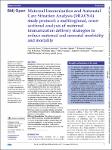Maternal Immunization and Antenatal Care Situation Analysis (MIACSA) study protocol: a multiregional, cross-sectional analysis of maternal immunization delivery strategies to reduce maternal and neonatal morbidity and mortality
Roos, Nathalie
Lambach, Philipp
Mantel, Carsten
Mason, Elizabeth
Muñoz, Flor M.
Giles, Michelle
Moran, Allisyn
Hombach, Joachim
Diaz, Theresa
MIACSA expert advisory panel group
Introduction Maternal immunization (MI) with tetanus
toxoid containing vaccine, is a safe and cost-effective
way of preventing neonatal tetanus. Given the prospect
of introducing new maternal vaccines in the near future,
it is essential to identify and understand current policies,
practices and unmet needs for introducing and/or scaling up
MI in low-income and middle-income countries (LMICs).
Methods and analysis The Maternal Immunization and
Antenatal Care Situation Analysis (MIACSA) is a mixed
methods, cross-sectional study that will collect data in
four phases: (1) a review of global databases for selected
health indicators in 136 LMICs; (2) a structured online
survey directed at Maternal, Newborn and Child Health
and Expanded Programme on Immunization focal points
in all 136 LMICs; (3) semistructured telephone interviews
of 30 selected LMICs and (4) 10 week-long country visits,
including key informant interviews, health facility visits
and focus group discussions. The principal analyses will
assess correlations between the various aspects of MI
delivery strategies and proxy measures of health systems
performance related to vaccine-preventable disease
control. The primary outcome will be a typology of existing
MI delivery models, and secondary outcomes will include
country profiles of child and maternal health indicators, and a
MI gaps and needs analysis.
Ethics and dissemination The protocol was approved
by the WHO Ethics Review Committee (ERC.0002908).
The results will be made available in a project report and
submitted for publication in peer-reviewed journals that
will be shared broadly among global health decisionmakers,
researchers, product developers and country-level
stakeholders.
Verwandte Publikationen
Anzeige der Publikationen mit ähnlichem Titel, Autor, Urheber und Thema.
-
2014-05-01ZeitschriftenartikelBreast-feeding and maternal risk of type 2 diabetes: a prospective study and meta-analysis Jäger, Susanne; Jacobs, Simone; Kröger, Janine; Fritsche, Andreas; Schienkiewitz, Anja; Rubin, Diana; Boeing, Heiner; Schulze, Matthias B.Aims/hypothesis: We aimed to examine the association between breast-feeding and maternal risk of type 2 diabetes and to investigate whether this association is mediated by anthropometric and biochemical factors. Methods: ...
-
2016-03-01ZeitschriftenartikelSocial Disparities in Maternal Smoking during Pregnancy Comparison of Two Birth Cohorts (1996–2002 and 2003–2012) Based on Data from the German KiGGS StudyKuntz, Benjamin; Lampert, ThomasBackground: Maternal smoking during pregnancy represents a significant developmental risk for the unborn child. This study investigated social differences in maternal smoking behavior during pregnancy in mothers living in ...
-
2011-03-01ZeitschriftenartikelIs low birth weight in the causal pathway of the association between maternal smoking in pregnancy and higher BMI in the offspring? Beyerlein, Andreas; Rückinger, Simon; Toschke, André Michael; Rosario, Angelika Schaffrath; Kries, Rüdiger vonA number of cross-sectional and prospective studies suggested a priming effect of maternal smoking in pregnancy on offspring’s obesity. It has been hypothesized that this association might be explained by low birth weight ...

